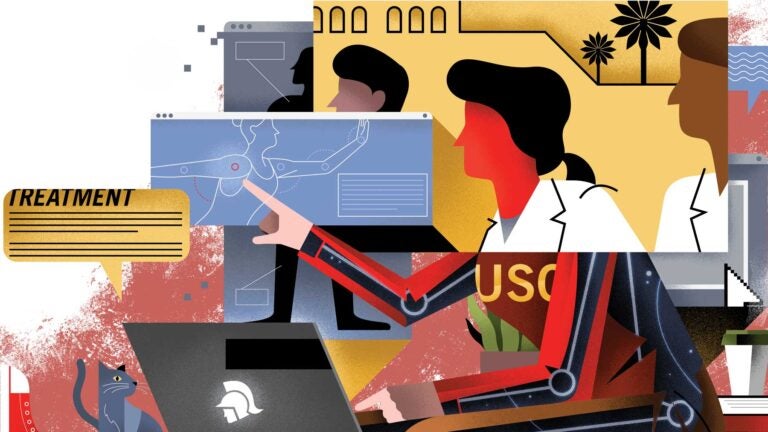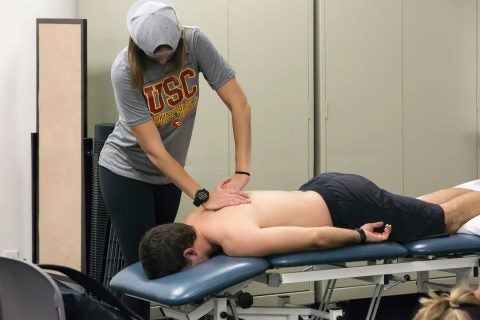
The DPT@USC program will be a combination of online and in-classroom instruction. (Illustration/Dave Murray, i2i Art)
USC’s physical therapy division starts online/on-campus doctorate
Online students in the new program DPT@USC will take the same courses as Trojans on campus — but in a different format
The USC Division of Biokinesiology and Physical Therapy is diving into the digital world with DPT@USC, an innovative online/on-campus hybrid program that reimagines the way doctors of physical therapy are trained.
The physical therapy job market is expected to increase by 34 percent — much higher than most other occupations — by 2024, the U.S. Bureau of Labor Statistics estimates.
With this in mind, the division began to assess the ways in which it might expand to not only help meet that demand but also to ensure the profession continued to be populated by high-quality physical therapists providing patient-centered, evidence-based care.
As one of the nation’s top-ranked physical therapy programs, the division considered its responsibility to help maintain the quantum leaps that the profession has made in the past two decades toward its now recognized position as a doctoring profession.
And how could it provide a top-ranked educational experience to ambitious prospective students across the nation who might not be able to relocate to Los Angeles?
Turning to technology
The answers came two years ago when the division was approached by 2U Inc., an education technology company that works with schools across the country — including the USC Rossier School of Education, the USC Suzanne Dworak-Peck School of Social Work and the USC Jimmy Iovine and Andre Young Academy — to build online degree programs comparable to their classroom-based counterparts.
2U was interested in doing the same for USC’s doctor of physical therapy program. Under the leadership of Associate Dean James Gordon, division faculty went through months of careful contemplation and discussion to figure out if it was the right move.
We all knew we wouldn’t do it if we couldn’t do it to the standards we hold for ourselves.
Julie Tilson
“We all knew we wouldn’t do it if we couldn’t do it to the standards we hold for ourselves,” said Associate Professor of Clinical Physical Therapy Julie Tilson DPT ’98, MS ’09.
The division decided to move forward and launch DPT@USC next summer.
“Our goal is to revolutionize how we educate physical therapists,” said Tilson, director of DPT@USC. “This is our opportunity to do just that.”
Questions and answers
Students in the new hybrid program will take the same courses as on-campus students — just in a different format. They will study full-time, starting each week with asynchronous content — video combined with bidirectional learning materials — that after 10-minute chunks of instruction will require them to answer questions by looking for information on their own or by meeting with other students.

Every week, DPT@USC students will also meet with a professor from each of the courses they’re taking to continue in a live-classroom environment. The ratio is one faculty member to 12 students.
“The motto of 2U is ‘no back row,’” Tilson said. “You really can’t hide and not be asked questions about the material.”
These meetings take place every week for every course, so on average, hybrid students will spend six to eight hours with faculty members in small-group settings every week.
And once or twice per semester, depending on the lab content, the hybrid students will be required to travel to USC for six- to eight-day stints. Once on campus, they’ll be attending lab sessions, building on what they’ve learned.
Examining what works — and what does not
Like the residential students, they will have mentorship and practice time during the immersion where they will refine and be tested on their physical skills. Over the three-year program, hybrid students are expected to be on campus approximately 60 days for hands-on clinical skills laboratories.
Associate Professor of Clinical Physical Therapy Dan Kirages ’94, DPT ’98 sees opportunity for both future hybrid students as well as those who are part of the traditional program.
Creating the hybrid program is allowing us to dissect our curriculum and really figure out what we are teaching, how we’re teaching it.
Dan Kirages
“Creating the hybrid program is allowing us to dissect our curriculum and really figure out what we are teaching, how we’re teaching it,” he said. “We’re laying it out on the table and translating it from the residential to the hybrid program.”
In designing the new program, Kirages said he can examine the efficiency and the content of the existing residential program and revamp certain things, if needed.
“That’s really good for a program because you want to stay fresh and think about new ways to disseminate information to students,” he said. “This is a process that prevents us from being stale.
Overcoming challenges
For someone in their 30s with a couple of kids and trying to change career paths, the opportunity to study at a world-class institution can be challenging. Tilson said that the program hopes to attract ambitious, dedicated future physical therapists who want to experience the rigor and excellence of USC physical therapy education and who feel that the hybrid environment with asynchronous and live sessions is a good fit for their learning style.
“That may be people who can’t relocate, maybe because a spouse has a job in another city, but they’re still able to make the full-time commitment,” she said.
While there are some other physical therapy online learning options, USC is the first research-intensive institution to offer a full-time entry-level doctor of physical therapy degree using a hybrid online/on-campus format.
“This program will continue to set us apart from the pack, and it does expand our reach,” Tilson said.
